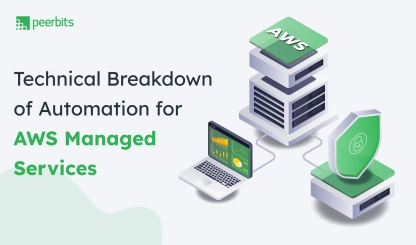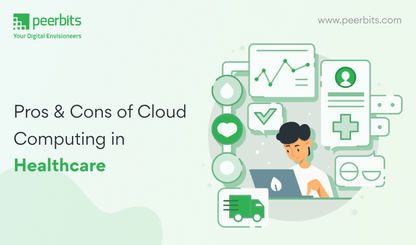Organizations rely on cloud services to stay ahead. One such service is Amazon Web Services (AWS) — a go-to choice for businesses of all sizes.
Organizations use AWS to reduce data center costs, improve resource usage, and move faster in areas like analytics and machine learning.
Per the Q2 2023 reports, AWS holds about 32% of the worldwide cloud infrastructure market. Part of the reason is the way cloud platforms have redefined the way businesses view and leverage technology in their functions.
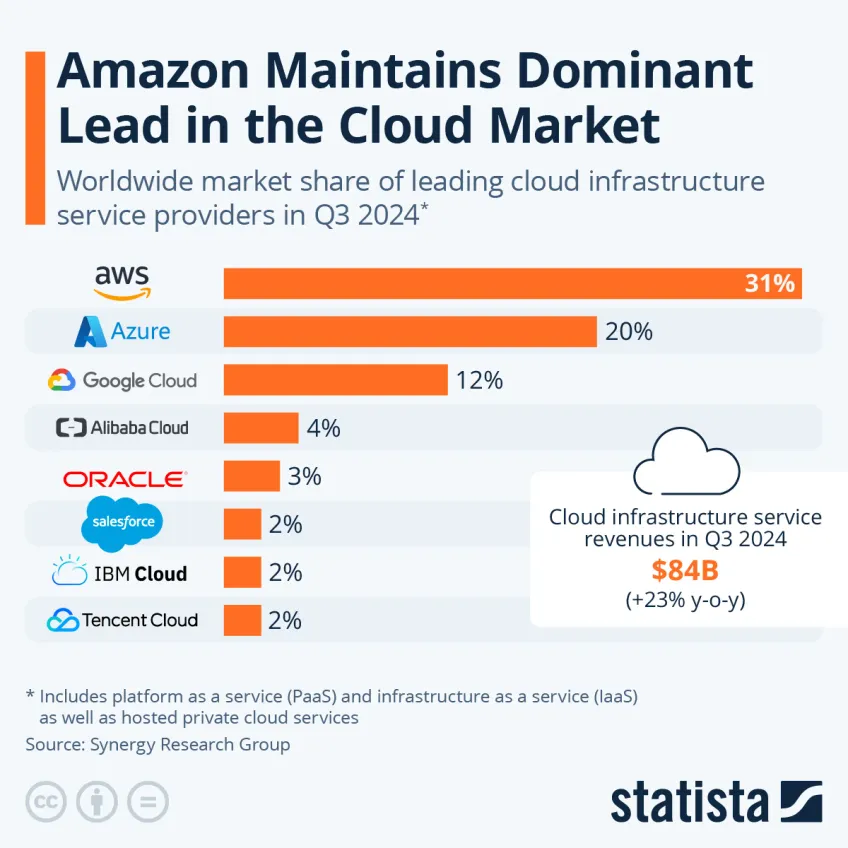
Here, AWS stands out for providing on-demand computing, storage, and innovative analytics tools. Many large enterprises and startups depend on it to shift away from bulky hardware setups.
Microsoft Azure and Google Cloud each have strong customer bases, yet AWS often remains the top choice because of its extensive global footprint. Such a huge market share is also due to AWS’ global network, which includes multiple regions and many availability zones that help businesses serve users across continents with lower delays.
When it comes to pulling everything together, AWS cloud consulting offers essential support.
AWS consulting for digital transformation helps follow a roadmap on what to adopt first, how to control costs, and ways to shield critical information.
Below, we’ll explore AWS cloud consulting for businesses in depth across different phases and action items for each.
What is AWS end-to-end consulting?
End-to-end AWS cloud consulting covers the entire path of a cloud journey — from initial planning to execution and even maintenance.
Expert AWS consultants follow a well-designed framework for each step.
What does end-to-end AWS cloud consulting include?
Consultants scrutinize existing infrastructure, plan new architectures, and make sure everything works as expected once workloads run in the cloud. AWS often rolls out new releases, so with experts by their side, businesses can track fresh possibilities.
For the same, the below aspects are included in the end-to-end AWS implementation consulting.
Service range — Initial assessments, architecture design, migration strategy, and ongoing optimization with support from licensed consultants.
Innovation — Evaluating newly-released features and integrating them to deliver tangible benefits.
Ecosystem & Community — Leverage a vast partner network, open-source contributions, and an active user community as AWS consultants help you tap into this ecosystem.
Scalability & Reliability — Ensures that the design, deployment, and application management follow high availability best practices.
Well-known adopters include Netflix and Spotify.
Netflix relies on AWS to serve massive streaming loads and analyze user data at scale.
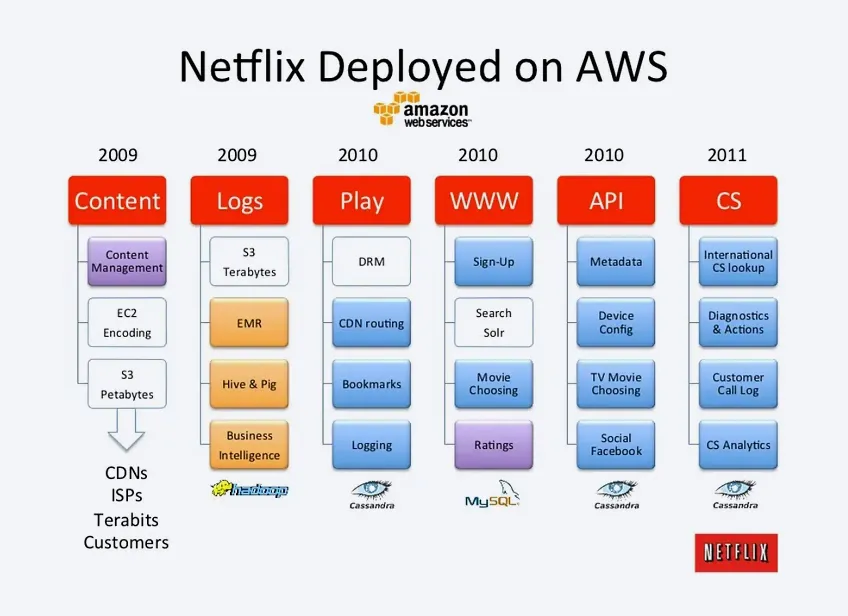
Similarly, Spotify uses those same capabilities to maintain a wide library of tracks and offer its listeners accurate recommendations.
Why AWS consulting is needed
Specialists in AWS cloud consulting for digital transformation shrink the learning curve and share methods for running reliable workloads.
It's one way to remain competitive and discover new growth paths in the following manner:
Expert guidance for optimal AWS utilization
Consultants who are good at planning and execution with AWS ensure you choose the right tools while they configure the cloud correctly. It lets you make the most out of AWS’s capabilities so that cloud investments remain on the right track.
Faster Cloud adoption
Migrating to the cloud with AWS consulting specialists streamlines each phase of cloud migration—planning, designing, and deployment—and offers quick results and faster returns.
Cost optimization and resource efficiency
Experienced AWS consulting partners enable trimming unnecessary expenses while effectively using every resource to maintain a lean, cost-efficient infrastructure.
Future-Proofing through innovation
AWS consultants help leverage new features and services to supercharge your business so that you stay on top of these updates.
Security and compliance
Protect sensitive data on the cloud with the specialized knowledge of AWS consultants since they follow security measures and regulatory requirements to strengthen your cloud defenses.
End-to-End AWS cloud consulting services (Phase wise)
Many businesses break down their AWS journey into logical steps that begin with planning and move toward a final rollout.
Such an approach removes guesswork, lowers risks, and provides a map for what should be done.
A. Phase 1: Planning
The first phase is where AWS consultants review the client’s vision, sum up technical gaps, and define a plan to meet goals.
A clear route for this phase is as follows.
I. Business and technical requirements
Consultants check on goals that matter most by conducting interviews with key leaders and technical experts. It is to identify gaps in current processes and define how success is measured.
Here, the AWS implementation consulting focuses on —
a. Identifying business & technical requirements
Mostlit, it is about stakeholder alignment to bring all voices together early on, including C-suite leadership, DevOps managers, and security officers.
b. Workload assessment & prioritization
Focus on revealing apps or services that should move first and which ones might need more preparation.
They’d typically —
- A rehost approach — lifting and moving apps with minimal changes
- A re-platform approach — incorporating moderate modification
- Refactor — rebuilding application parts.
i. Analyze applications and workflows explicitly for migration decisions.
ii. Identify and classify workflow complexity — Choosing either or a mix of these;
iii. Analyze readiness for cloud migration — Ensures access network bandwidth, security setups, and compliance criteria to meet essential prerequisites.
II. Financial and TCO analysis
The AWS consulting for startups and enterprises requires gauging the spending and forecasting for AWS planning.
Here, AWS consultants consider the following major aspects:
a. AWS pricing models
It’s about comparing and choosing a thoughtful mix of these models to lower monthly bills —
i. On-demand — the primary options are
b. Return on Investment (ROI)
AWS consultants will run an analysis for the following:
- i. Estimated cost savings over on-premises infrastructure — Requires evaluating cost factors that are directly replaced, optimized, or reduced in the cloud environment. For instance, switching from on-premises data centers can free up funds spent on physical servers and maintenance.
- ii. Weighing in intangible Benefits that AWS offers — Using tools like AWS Pricing Calculator to gauge future costs and gain intangible benefits through faster product releases.
- i. Scaling patterns and potential spike periods — Estimating current usage, seasonal changes, and possible expansion to check for large swings in traffic.
- ii. Cost optimization strategies — AWS implementation can quickly inflate spending if services are left running without checks. Tools like the AWS Pricing Calculator give early projections and intangible benefits resulting from faster product launches, shorter maintenance, etc.
c. Budgeting & forecasting
At this stage, the AWS implementation consulting will involve checking for budgeting and forecasting for the following:
III. Governance and security requirements
Recent findings indicate that businesses might lose around $4.88 million if they skip necessary cloud defenses by 2024. That figure places cybersecurity at the front of any cloud planning phase.
- i. Different sectors follow different regulatory compliances.
- Healthcare has HIPAA, payment services work with PCI DSS, and European businesses observe GDPR.
- ii. AWS already has certifications such as ISO 27001 and SOC 2 that boost confidence.
a. Regulatory compliance
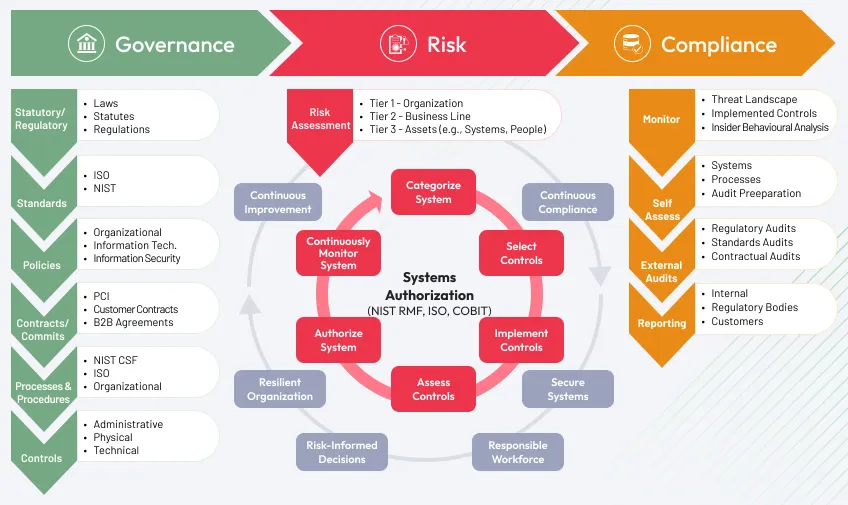
- i. Roles and permissions strategy — Clearly define who has the power to change settings, create new resources and modify existing services.
- ii. Tools to use — AWS IAM (native tool), AWS Single Sign-On (SSO), AWS Organizations to manage multiple AWS accounts, Okta (3rd-party IAM solution), etc.
b. Identity & access management (IAM)
c. Policies and controls
A well-defined set of rules sets the standard for resource usage, cost alerts, and secure design.
i. Establishing governance frameworks — requires working closely with stakeholders to define and document policies, roles, and responsibilities aligning with the organization’s operational goals.
ii. Best practices — Setting up governance by;
-
Leveraging Infrastructure as Code (e.g., AWS CloudFormation)
-
Implementing cost and usage policies (e.g., cost alerts)
-
Enabling AWS Config and AWS Control Tower for continuous compliance checks
-
Enforcing least-privilege access
IV. Architecture design
Designing the structure of an AWS setup in advance can save businesses from future challenges.
a. High-Level architectural vision
A macro-level vision of the AWS architectural framework requires deciding on the following:
-
i. Single-region vs. Multi-region approach — Single-region setups are simpler, while multi-region solutions support better uptime and handle region-specific requirements.
-
ii. Data residency constraints — Determining a few workloads to keep data in a specific region due to regulatory rules.
b. Reference architecture
AWS consultants consider the following here:
-
i. Workload selection — reference architectures guide decisions by showing patterns for:
-
Three-tier apps have separate the presentation layer (frontend), application layer (backend logic), and database layer.
-
Data pipelines are used to analyze patterns for ingesting, processing, and analyzing large data streams to derive insights quickly.
-
Microservices where distributed systems enable independent deployment and scaling of individual service components.
-
ii. Leveraging the AWS Solutions Library to check examples of sample design.
c. Well-Architected pillars
AWS experts perform cloud automation with AWS by adhering to a few principles of cloud architecture.

-
i. Operational excellence — Running and monitoring systems to deliver business value.
-
ii. Security — Protecting data, systems, and assets using AWS services.
-
iii. Reliability — Quick recovery from disruptions and scaling with AWS cloud computing resources.
-
iv. Performance efficiency — Optimizing workload performance via right-sizing and caching strategies.
d. Impact on development changes
Often, AWS developers require updates within the system, which results in a huge impact on the following areas:
-
I. Codebase updates become necessary for apps to benefit from cloud-native features.
-
ii. Testing processes might shift toward container or serverless patterns.
-
iii. Continuous delivery workflows are created to reduce downtime and automate releases.
V. Migration strategy
Many businesses have existing systems that need to move over. Or, existing systems are part of the plan, and consultants need to figure out a migration approach.
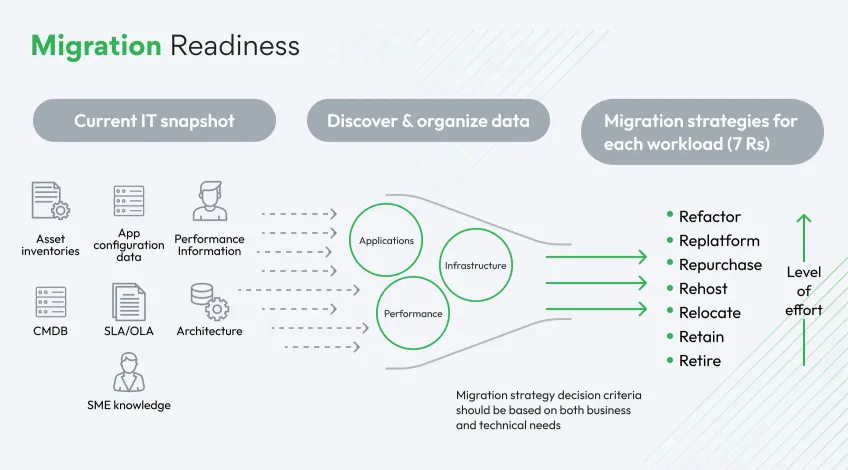
Here, experts in cloud automation with AWS can help identify which apps to move and in what order by running a small proof-of-concept before a complete transition.
B. Phase II: Execution
This phase is about the AWS implementation, where consulting agents build out environments, move data or applications, and confirm that security controls match the agreed standards.
Here, the following actions are taken in a phased manner.
I. Infrastructure provisioning
Establishing AWS resources as a project milestone wherein the AWS consultants rely on the following:
a. Infrastructure-as-Code (IaC)
IaC gives everyone a record of every change to accelerate builds by allowing environments to be duplicated on demand with automated approaches reducing errors.

-
i. Tools to use — AWS CloudFormation, Terraform, AWS Cloud Development Kit, etc.
-
ii. Benefits —
- Versioning: Each template update is tracked so that teams know who changed what.
- Repeatability: Spinning or replacing the entire environment using the same instructions.
- Automated deployments: Scripts or pipelines run the provisioning steps to reduce human effort.
b. Considering networking setup
Consultants design how traffic moves between services and decide how on-premises networks connect to the cloud.
i. VPC design: It splits off a dedicated slice of AWS as explained in the image below.
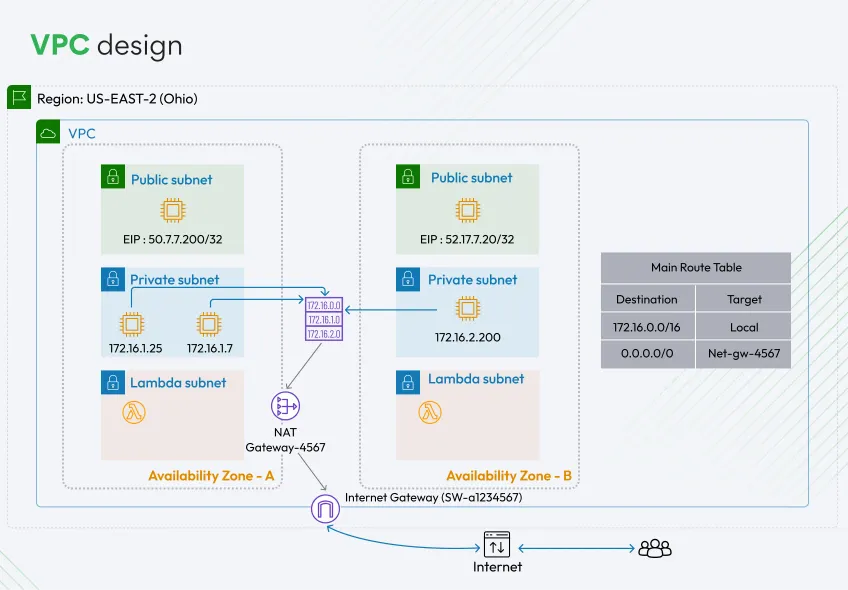
-
Subnets to break down the VPC into smaller network zones.
-
Routing tables for directing traffic between subnets and beyond.
-
NAT gateways allow internal instances to reach the internet without exposing private addresses.
AWS consultants leverage —
- Direct connect creates a private, wired line from a local data center to AWS.
- VPN which encrypts traffic over a shared public network for a secure link.
- AWS Transit Gateway to create a hub that ties together multiple VPCs or on-premises links under one management plane.
II. Security implementation
Security experts secure each layer of the environment by developing strategies for blocking risks, encrypting sensitive data, and detecting unusual behaviors.
Often, it involves the following action items —
a. Network security Controls are placed at different levels to limit exposure to malicious traffic.
- i. Security groups — to manage what traffic is allowed per instance.
- ii. Network ACLs — to operate at the subnet level, blocking or permitting traffic.
- iii. WAF (Web Application Firewall) — to explore HTTP requests for threats such as SQL injection or cross-site scripting.
b. Data protection
Automating cloud infrastructure with AWS requires applying data protection with the following consideration.
- i. Implementing encryption at rest (using KMS keys) and in transit (using TLS) to encode the data against unauthorized users.
- ii. Backup & disaster recovery (DR) strategy with AWS Backup to keep snapshots of data for future restoration in the event of loss or corruption.
c. Monitoring & threat detection
AWS planning and deployment requires monitoring resource activity in real time to lower the chance of missing a breach or misconfiguration.
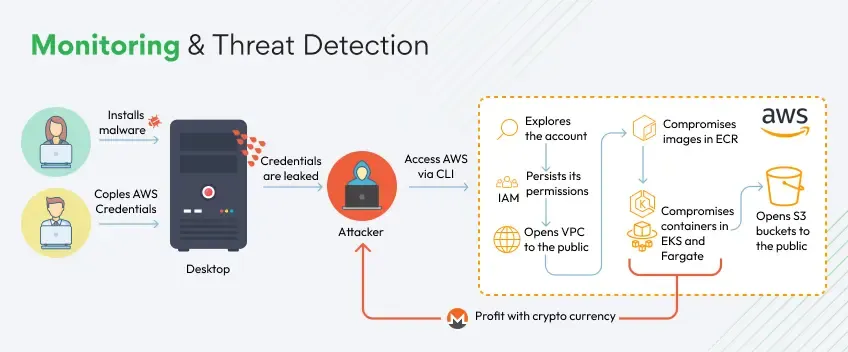
It requires using:
- i. Amazon GuardDuty for scanning malicious patterns in logs and network flows.
- ii. AWS Config to keep track of resource changes and check against the rules.
- iii. CloudWatch** to collect log data in a centralized location for analyzing issues and debugging.
III. Application deployment & configuration
When automating your AWS cloud infrastructure, consultants configure your application or software, so it easily adapts to different environments.
They employ the below techniques so that updates roll out without causing disruptions or downtime.
a. Continuous Integration & Continuous Delivery (CI/CD) AWS consultants adopt this approach to tie together code building, testing, and deployment in one automated pipeline.
It involves —
- i. Using AWS services — with tools like AWS CodePipeline, CodeBuild, and CodeDeploy that tie commits to building triggers that push working versions automatically.
- ii. Implementing best practices — by using automated tests that validate changes, code quality checks to reduce bugs, and zero-downtime deployments so as to keep systems running.
b. Containerization & serverless
Both these are methods to reduce overhead by abstracting away some or all server management tasks.
- i. Containers: Amazon ECS and Amazon EKS are platforms that help package apps with their dependencies so that teams can run and scale them consistently across Environments.
- ii. Serverless: AWS Lambda and Amazon API Gateway run code only when prompted without the need to maintain entire servers.
IV. Data and analytics
Many teams want to do more with their data once the foundation is set, from basic reporting to advanced analytics. So they can use the database and analytical pipeline in the execution phase of the AWS implementation.
a. Database
A single project might include multiple storage types.
- i. Relational databases — storing structured records and fitting scenarios like traditional transactions.
- ii. NoSQL — handling flexible data that shape large-scale use cases.
- iii. Data warehousing — centralizes large volumes of data for deeper queries, sometimes paired with caching layers for faster reads.
b. Analytics pipeline
Setting up a pipeline for ingestion, transformation, and reporting can reveal hidden insights. Streams of data often flow in through Amazon Kinesis, then land in a data lake (such as S3).
AWS implementation consulting experts leverage services like AWS Glue to handle transformations and reporting tools such as Amazon QuickSight so that decision-makers have a visual way to interpret results.
Example: Coca-Cola
Coca-Cola created a serverless model on AWS to manage vending machine data and user engagement.
By migrating these tasks, they freed up resources to focus on real-time promotions and product insights, scaling to meet demands as needed.
D. Phase III: Post-Implementation and optimization
This stage is about keeping AWS solutions stable, secure, and tuned for ongoing needs. Even if the planning and rollout were successful, there can still be hidden issues that appear over time.
It's here that the AWS cost optimization consulting consultants come to the fore and analyze performance gaps, security blind spots, and compliance hurdles.
The post-implementation phase of AWS implementation consulting involves the below key aspects.
I. Monitoring & observability
Data collection and alerting become daily tasks. Log checks and integrated dashboards monitor resource behavior.
a. Logging and Metrics
This needs capturing details about system behavior, such as CPU usage or how fast a request completes.
For this, post-implementation AWS cloud consulting includes the following:
-
i. Core tools to use and their purposes — Like Amazon CloudWatch to track metrics and stores logs, AWS X-Ray to trace requests across multiple services, and AWS CloudTrail to log account-level activities.
-
ii. Third-party integration — With platforms like Splunk or Datadog ingest logs for advanced search, correlation, or custom dashboards to enable linking multiple data sources into a single view for spotting patterns.
b. Automated alerts & incident response
It is a necessary action item for AWS implementation to stay on top of alerts since it keeps outages short or even prevents them.
i. Event-driven notifications — This includes;
- SNS to fan out messages to many channels at once.
- Slack posts alert relevant teams to discuss them in real-time.
- Email as a backup or for lower-priority messages.
ii. Auto-remediation using AWS Lambda triggers — a function to take immediate action.
For example, if an EC2 instance misbehaves, Lambda might restart it automatically by removing the wait time for human intervention and keeping services Running.
II. Security and compliance updates
With threats always evolving, AWS planning and deployment must be followed by adequate post-implementation steps to evaluate defenses and meet regulations.
This demands the following actions —
a. Security Posture Review
AWS security experts run periodic checks to confirm key safeguards work as intended. Most often, this means;
-
i. Running periodic checks — involving port scans, validation of IAM policies, and ensuring encryption such that out-of-compliance resource slips can be fixed before the breach.
-
ii. Patching and vulnerability assessments — so that systems do not fall behind when running updates as regular patch cycles and scanning tools are used.
b. Compliance audits
The majority of compliance tasks in the post-implementation of AWS are for meeting external standards to build confidence with clients and partners.
This includes the following action items:
-
i. Using tools like AWS Config that can highlight resources that violate security rules and AWS Security Hub to bring multiple checks into one place.
-
ii. Running industry-specific audits as follows: SOC2 focuses on data handling, PCI covers payment card data, and HIPAA addresses patient privacy in healthcare.
III. Performance tuning
Resource demands often shift once workloads run in the real world.
AWS Consultants measure usage, carry out stress tests, and make adjustments to keep things running smoothly.
a. Load testing & scaling This involves using different tools that guide decisions on scaling up instance sizes or adding more instances to handle spikes. For example, Distributed Load Testing on AWS or third-party utilities like Apache JMeter can help push apps to their limits.
b. Caching & content delivery Rapid response times shape user perceptions of reliability, and this needs AWS post-implementation services to focus on these services:
-
i. Amazon CloudFront — to push content closer to users by caching it at edge locations worldwide, cutting latency.
-
ii. ElastiCache for Redis/Memcached, etc. — to keep frequently accessed data in memory for fetching repeated items quickly from databases or external services.
c. Database optimization Data operations can slow if queries aren’t structured well, so this requires;
-
i. Index optimization — to add or refine indexes that help the database find records Faster.
-
ii. Query analysis — for reviewing how each query runs, focus on areas to simplify, merge, or rewrite for better performance.
-
iii. Read replicas — by sending read requests to replicas, the primary database avoids overload, which in turn helps amidst high-traffic events.
Sample engagement model
Once you choose the AWS implementation, the next thing you’d do is to have an engagement model.
You can align team calendars, clarify responsibilities, and confirm milestones so that everyone understands priorities and pace.
Below is the sample model with the timeline and work that you can expect to get done when working with AWS consultants.
Kickoff & assessment (Week 1-2)
During the first two weeks, your team meets consultants, defines initial goals, and collects foundational information.
Stakeholder workshops give everyone a voice in shaping the project. These sessions reveal high-level objectives and concerns. Technical & business requirements are gathered so the solution reflects genuine needs, not just guesswork. TCO/ROI analysis and compliance gap assessments verify that potential benefits outweigh costs, wherein AWS consultants spot any rules or regulations that might affect the approach.
Design & planning (Week 2-4)
In the next couple of weeks, consultants draft the underlying framework based on what was discovered in Phase I. It involves;
High-level solution architecture and migration strategies from a broad sketch of what the AWS setup will look like. Project roadmap with success metrics and cost estimates with predefined milestones, how to measure it, and expenses to expect.
Pilot & proof of concept (Week 4-6)
Next, a smaller segment of the environment is introduced to AWS to validate assumptions and see how everything behaves under real conditions.
The pilot workload will need to move one key application or build a single test environment.
You’ll have architecture validated for performance and security controls to spot weaknesses early on for fixes.
Full implementation (Week 6-12+)
With lessons learned from the pilot, it’s time for the major rollout by taking the following actions:
Setting up provision infrastructure with AWS CloudFormation or Terraform to maintain consistency across environments.
Deploying CI/CD pipeline to keep upgrades and fixes flowing seamlessly, avoiding outages.
Migrating workloads or building greenfield applications marks the main shift to AWS or the start of new projects built natively in the cloud.
Monitoring, logging, and backup strategies get established, so you always know how your systems are performing and have a fallback plan in place.
Validation & optimization (Week 12-16+)
After running the primary workloads, consultants fine-tune the environment for performance, security, and cost.
Fine-tuning performance, cost, and security to adjust compute instances or refine monitoring.
Well-architected reviews check whether the solution meets best practices across all AWS pillars.
Evaluating analytics use cases if your data strategy calls for deeper insights, such as large-scale processing or dashboarding tools.
Post-Implementation (Ongoing) It’s a long-term upkeep phase to make sure that the environment remains secure, cost-effective, and prepared for change.
It involves:
Monitoring system health and security posture to keep an eye on potential issues before they disrupt operations.
Ensure continuous optimization for addressing new challenges or workloads that help you stay agile in the cloud.
Planning next phases to open doors to more advanced AWS features and expansions.
Conclusion
Moving to AWS or enhancing an existing cloud presence takes more than flipping a switch. It requires solid groundwork, thoughtful design, real-world testing, careful rollout, and periodic reviews.
The steps above give you a clear timeline of what happens and help you avoid surprises and keep your goals in sight.




